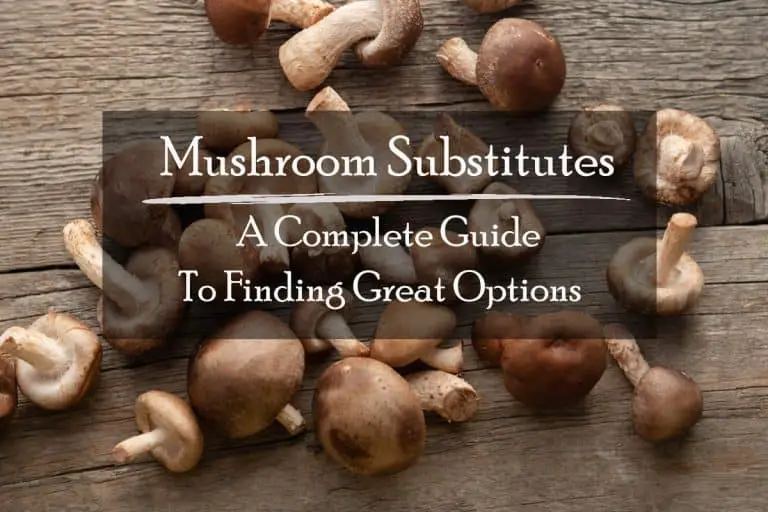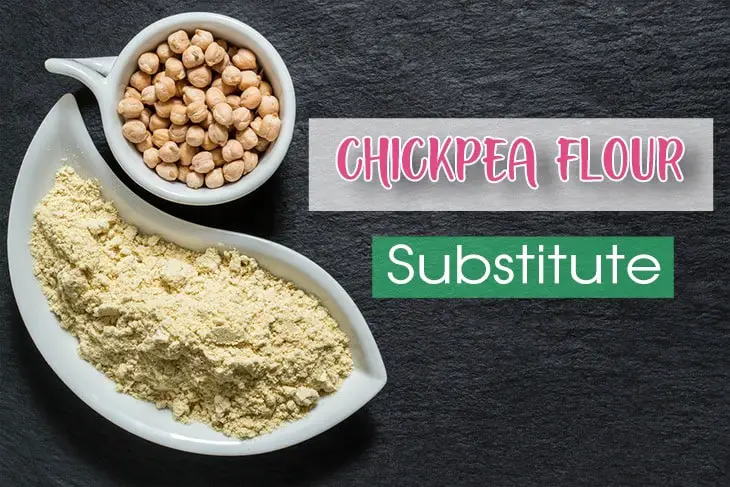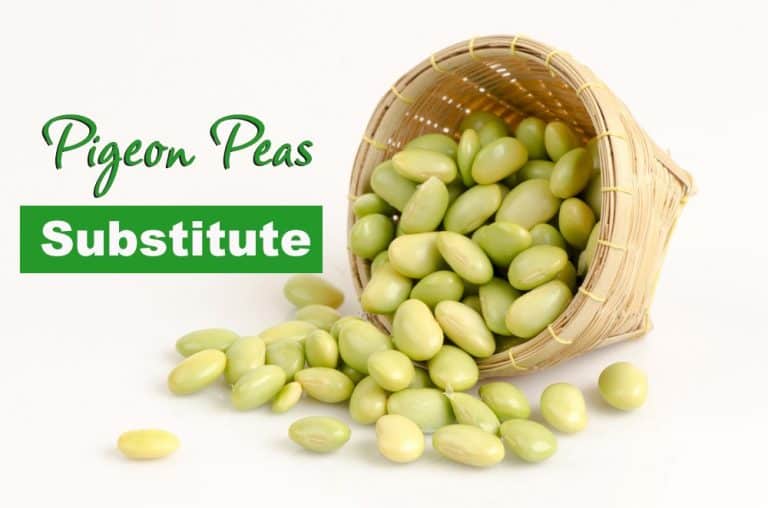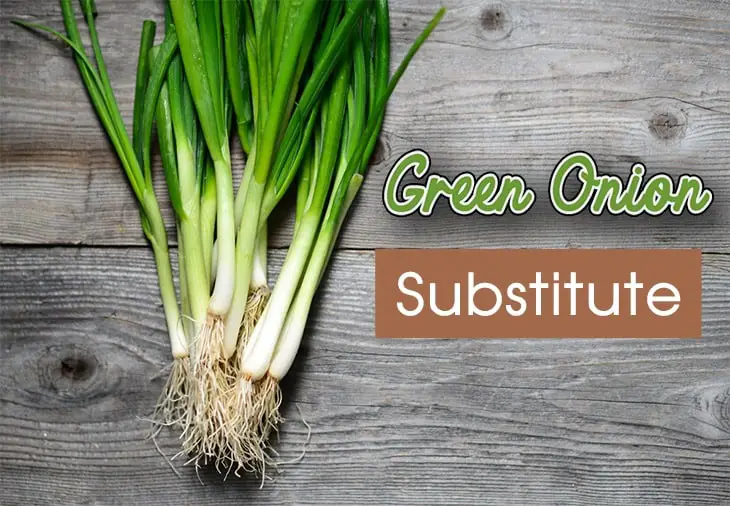
Things can go wrong if you lack some ingredients when cooking. Therefore, finding alternatives is incredibly important. In this article, we introduce you to the substitute for green onion list.
Green onion is usually used as a garnish or dressing of a dish, not the main ingredient. For this reason, you are more likely to forget green onion when shopping or run out of it without notice. What else in the kitchen can replace it then?
The answers are right below. Let’s check it out!
Top 12 Substitutes For Green Onion
Green onion consists of two parts: green leaves and white bulbs. We base on this feature to recommend some candidates with comparable appearance and flavor. Here are 12 ideas to replace this dressing.
1. Green Onion Powder
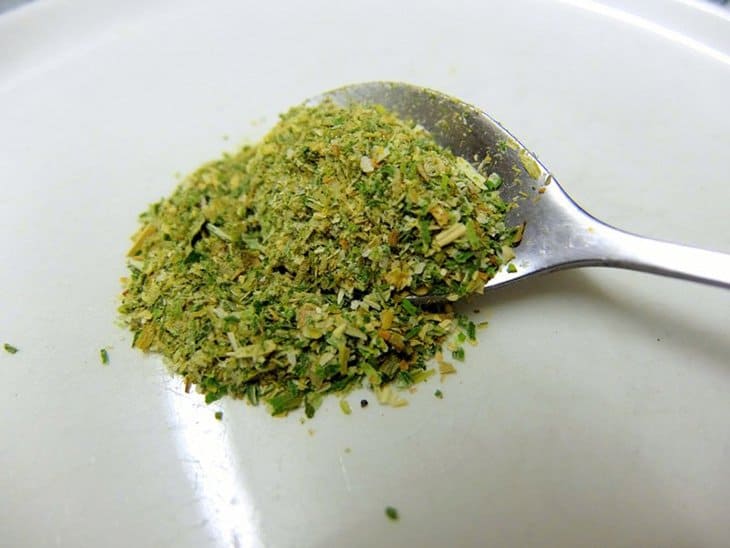
It goes without saying that green onion-based products are the best substitute for this plant. Green onion powder is an example. Although it does not come with a fresh and herby flavor, you will experience a mild and oniony taste.
You can add some of this powder to stews, soups, sauces, or any recipes calling for green onions. Also, sprinkling it on pizza, fried food, or pasta can make an eye-catching outlook.
We recommend trying green onion crackers, too. Mixing some green onion powder with flour will bring out a grassy-sweet flavor. Combined with the crunchy texture, these crackers are perfect snacks for kids and adults.
When dried and ground, green onions will lose some nutritional benefits. However, its powder is still packed with vitamin K, and C. Vitamin K supports blood clotting and bone health, while vitamin C can boost your energy and mood.
Putting green onion powder in a tofu dish is not a good idea. Oxalic acid in green onion will turn to calcium oxalate, hindering your body from absorbing calcium.
2. Chives

Chives, with small and thin green leaves, can add the same oniony taste like green onion in a recipe. The only difference is that chives are less crunchy and do not come with white bulbs.
Like green onions, chives can be used as garnishes in soups, dips, or any dish you want. It goes well with other ingredients, bringing a vibrant green and a hint of herby flavor to the dish.
You can add some chives as a seasoning, too. When pairing with parsley, tarragon, or chervil, it creates a classic French herb seasoning. Chefs also commonly use them in cream-based sauces to serve with seafood recipes.
Some studies have found that chives can prevent cancer; thus, having them on your daily meal is vital. Not to mention, choline in chives supports good memory and brings you a sound sleep.
Chives are so delicate that they easily get bruised. Therefore, it is better to use a sharp stainless knife to cut fresh chives.
3. Leeks

Known as the bigger version of green onions, leeks can be a close match for this herb. They are denser and firmer than green onion, imparting a more intensely onion-like flavor to a dish.
Leeks can act as a garnish or a seasoning in any cooked recipe. Thanks to the huge body, they can also be grilled, roasted, or sautéed to serve as a side dish.
You should try roasted leeks with olive oil and pepper. The white stems will turn out more tender, sweeter, coming with a pleasing scent of the herb.
Leeks contain a great number of flavonoids, a versatile antioxidant with anti-inflammatory and anti-diabetic properties. Regularly consuming leeks can promote your heart health and digestion. Vitamin A found in leeks also does wonders for your vision.
When cutting leeks, remember to remove the dark green parts and thinly cut them into half-moons. This way can reduce their intense flavor when serving raw as a garnish.
4. Ramps
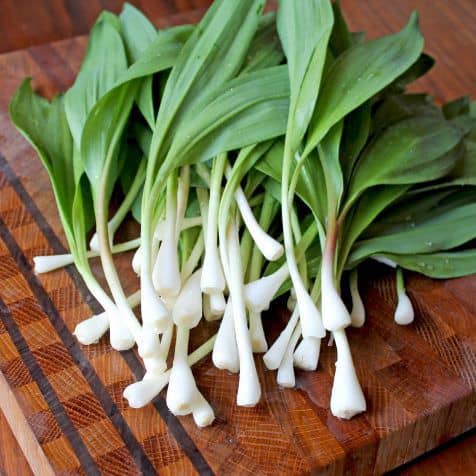
Ramps can grow wild in many areas, known as wild leeks. This plant is a mixture of garlic and green onion in taste. Therefore, you can replace green onions with ramps in a pinch.
They come with a stronger flavor than green onion, so you should never use them as a garnish but serve with cooked recipes or sauces. Also, vinegar can enhance ramps’ flavor, so they are ideal for pickling.
We want to introduce you to a super exceptional recipe – Ramp jam. The secret is to add sugar and vinegar when cooking over medium heat to eliminate the pungent flavor. This savory jam pairs well with eggs, steak, or shaved pork loin.
Basically, ramps deliver the same health benefits as leeks. They can aid heart health and digestion. Besides, a significant amount of iron in ramps smooth the oxygen-carrying path, thus boosting your general energy.
It is advisable to use ramps in a cooked preparation. The tangy taste could be too overpowering in a raw dish.
5. Shallots
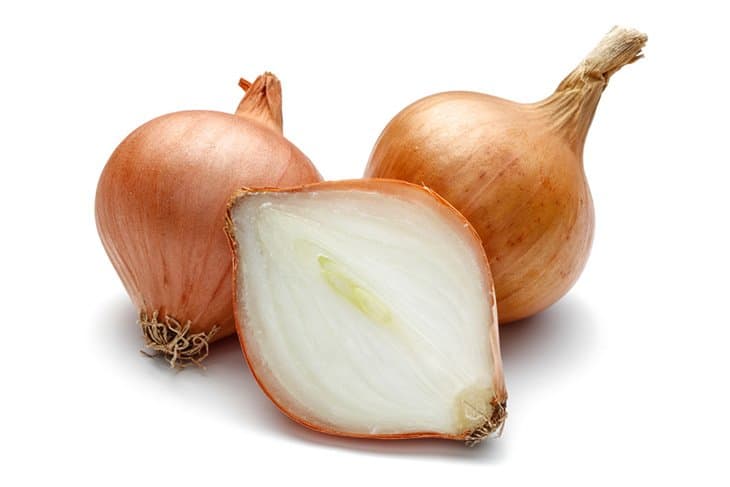
Another proper substitute for green onion is shallots. They resemble the aroma and tanginess of green onion but bring out a sweeter and milder flavor when cooked.
You are free to add shallots to soups, pizza, or pasta to brighten them with a touch of spice. Also, they can be used to make sauces or pickled shallots as a side dish.
But we want to blow up your mind with the Shallot Tatin. This twist with sweet and sticky caramelized shallots can be a main course for vegans based on the apple tart recipe.
Research shows that type-2 diabetic women can benefit from eating shallots with yogurt. This mixture reduces bad cholesterol and triglycerides for the progress of diabetes treatment.
Besides, shallots come with an antibacterial property to fight off viruses and germs, giving you a stronger immune system.
To reach the desired sweetness when sautéed, you should cook shallots slowly over low heat. Otherwise, they tend to burn easily and get bitter.
6. Onions

White, red, or yellow onions deliver a pungent and onion-like flavor; thus, you can use them as a replacement. The reason lies in their tangy and strong taste, possibly replacing the white bulbs of green onions but not their leaves. But onions turn sweet when cooked.
Due to its pungency, minced onions are best used at the start of cooking to bring an oniony and aromatic kick to the dish. However, onions are famous for their snack recipes.
Let’s get a flashback to your salad days with onion rings. Enjoy the crispy and flavorful flour wrap with the sweet onion inside, served with spicy chili sauce. What can be better for a snack?
Onions come with many antioxidants to reduce cholesterol, thus lowering the risk of heart disease. Furthermore, there is a great amount of folic acid in onions. This acid helps your body to generate healthy new cells.
To prevent tears when cutting onions, we recommend putting them in the freezer beforehand and not cutting off their roots.
7. Spring Garlic

Spring garlic, or green garlic, is immature garlic. You can take advantage of its tender leaves and white bulbs as a replacement for green onion. This plant brings out a hint of spice like green onion yet with a garlic smell.
You can enjoy sautéed green garlic with other vegetables or add it to soup or salad dressing. Not only that, roasted spring garlic can be served with cheese or spread on crispy toast.
Making green garlic pickles is also a great idea. The acidity of the vinegar will erase the pungency of garlic and replace it with a sweet and sour taste instead. These pickles can make you mouth-watering when mixing with salads or cheese and crackers.
The powerful antioxidant in green garlic – allicin – will boost your immune system and protect you from flu, cold, or cough. Including polysulfide, spring onion is also a heart-friendly plant.
You don’t need to peel off the bulbs before chopping. They are tender and will enhance the garlicky flavor of your dishes.
8. Garlic

You can’t get close to the green onion flavor if you use garlic. But it will have a tangy and spicy taste and somehow can replace green onion. Minced garlic is preferred because small pieces give you more flavor.
Adding minced garlic to soups or cooked recipes can glorify their flavor. If you can bear its strong pungency, you can also mix garlic with salads.
Besides, you should give the eggplant with garlic sauce a try. It is a quick and simple dish for vegans and non-vegans. At the first moment you taste it, experience the perfect combination of sweet and tangy garlic sauce and melt-in-the-mouth eggplants.
If you are not into or allergic to eggplants, you can use eggplant substitutes instead. The final plate is just fine.
Like green garlic, mature garlic also contains allicin, an antioxidant to protect you from infections and illness. Besides, you can experience a reduction in blood pressure because garlic promotes the synthesis of nitric oxide.
When adding garlic to your dish, make sure you keep the heat as low as possible. Otherwise, the garlic will end up burning.
9. Parsley

Parsley comes with a herby and attractive aroma, making it perfect for garnishing. Its green color can resemble green onion and bring out a little change in the original recipe.
This herb is a versatile ingredient. You can use it as a dressing on pasta, soups, and stir-fries or mix it with salad for a punch of flavor.
Otherwise, try Herbed chicken breasts. The crispy chicken is perfectly matched with the fresh parsley, easing the grease and whetting your appetite.
Parsley has a great nutritional profile, coming with a ton of vitamin A, K, and C. Your bone and eye health will benefit from vitamin A and K. Meanwhile, vitamin C can boost your immune system and your overall energy.
If you are about to use parsley as a garnish, add it to your dish after turning off the heat. Too much heat will make parsley mushy and less green.
10. Saw-Leaf Herbs

Originally from Asia, you will find it hard to see saw-leaf herbs in some American or European grocery stores. But if you have it on hand, this herby and aromatic plant can take the place of green onion.
Saw-leaf herbs can be a decent dressing, adding a fresh green for eye appeal. Besides, it pairs well with any soup, especially Pho, and enhances the flavor of the dish with its unique aroma.
Those struggling with bad breath will find this herb an effective remedy. Eating raw saw-leaf herb can help you eliminate the bad smell in a short time.
Moreover, there is a significant amount of iron in this plant. Iron is an essential element to stimulate oxygen-carrying, thus boosting your energy.
Like parsley, the saw-leaf herb is also a delicate plant. Remember to add it at the last minute to maintain its flavor, color, and health benefits.
11. Basil

Basil provides you with a peppery and slightly pungent taste yet a sweet smell. This mixed feature makes it ideal for garnishing sweet and savory dishes. Thus, you can always use basil instead of green onion in dressing.
Other than being a garnish, basil can pop up in salads and vegan grilled skewers to brighten their flavor. Even better, you can make Strawberry basil shortcakes if you love a not-too-sweet dessert.
What about drinks? Try out a glass of Gin Basil Smash. The sourness of lemon and the fresh basil will cool down your heat on a summer day.
Basil is packed with many antioxidants, reducing oxidative stress and alleviating your anxiety. It is also an excellent source of vitamin K and calcium to support your bone health.
It would be better if you tear the basil by hand instead of using a knife. A sharp knife will blacken the leaves and make it less attractive for garnishing.
12. Celery

Some of you may look for a green onion substitute because you can’t stand its tangy and pungent taste. Then celery is what you need. This plant comes with a mild flavor and crunchy texture. You can make use of its leaves when calling for green onions.
Slice celery leaves into small pieces and sprinkle on pasta or soups. You will have a nice visual as a garnish. Otherwise, there are thousands of celery recipes to pick.
You can make salads or even juice for a healthy breakfast. Celery can go well with other vegetables; thus, you can use it in stews and stir-fries.
Celery is prized as a superfood, low in calories but high in nutrients. Therefore, it is a good friend of dieters. Coming with an antiseptic property, celery can prevent bladder disorders and kidney problems.
Moreover, vitamin C in celery can boost your immune system to protect you from illness.
When it comes to celery’s favored partners, we suggest butter, blue cheese, shellfish, poultry, and chicken soup.
13. Skip it
Above are 12 alternatives for green onion you can easily put your hand on. However, if you are in a rush and can’t find a proper substitute, just skip it.
This thing might upset green onion lovers, but it is your final resort. A dressing or seasoning like green onion can be omitted without a big change in the recipe.
To make sure green onion is always available, please check out our growing and storing guides below.
Frequently Asked Questions
We will help you find out the answers to some common questions, thus allowing you to understand the benefits of green onion plus how to grow and store it.
What Are The Health Benefits Of Green Onion?
We have to admit that this leafy veggie is small but mighty. A one-cup serving of green onion can provide you with:
- Only 32 calories and zero cholesterol
- Twice daily value for vitamin K
- 25% of recommended daily amount of vitamin C
- Nearly 16% of folate amount needed per day
Vitamin K plays an important role in blood clotting, which in turn fosters wound healing. Your bones can also benefit from this vitamin, thanks to the calcium metabolizing function.
Vitamin C, an antioxidant, helps protect cells from damage and boosts the immune system. Not to mention, folate in green onions contributes to blood cells and DNA production. Pregnant women can take advantage of this benefit.
How Can You Grow Green Onion At Home?

Green onion is an easy-going plant, not requiring special care to develop. Plus, they are usually sold with root ends, making it easier to grow them at home. Below are 5 simple steps for your homemade green onions:
Step 1: Cut off the white bulbs (1-2 inches), make sure the roots attached
Step 2: Put the bulbs into a small jar, cup, or any proper container. Fill enough water to cover the roots. The rest must be dry; otherwise, they will soon be rotten.
Step 3: Place the jar near windows or any light-facing place. Change the water every one week. You will see the fast-growing of green shoots.
Step 4: When the shoots reach 4-5 inches long, it’s time for repotting. You can convert them to the ground or pots for better productivity. Keeping green onions in the jar will weaken them and make them stop producing.
Step 5: Time to harvest. Remember to cut all the green parts to make sure they grow again.
How To Store Green Onion For A Long Time?
We will tell you the secret to keeping green onions fresh for up to 5 weeks. When it comes to this trick, the key is to retain enough moisture. Here is a 5-step guide for you:
Step 1: Slice off the roots. The leaves will rot soon if there is excess moisture from the roots.
Step 2: Let them line up and cut in half so that they can fit in a plastic bag.
Step 3: Dry them off using a paper towel.
Step 4: Wrap green onions with paper towels. Don’t wrap too tight to avoid crushing.
Step 5: Place the wrapped green onions in a plastic zip bag and store them in your fridge. Remember to label with the date.
Conclusion
Have you found out the right substitute for green onion yet? Listed above are all the familiar ingredients in the kitchen, enabling easy replacement. Even when you can’t find anything, it’s up to you to skip it without making a big change in the recipe.
You can also use other kinds out of the list, as long as you are satisfied with the result. Give them a try and enjoy the fresh wind.

